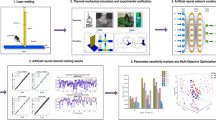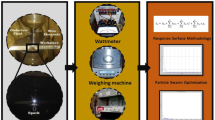Abstract
Recently, twist extrusion has found extensive applications as a novel method of severe plastic deformation for grain refining of materials. In this paper, two prominent predictive models, response surface method and artificial neural network (ANN) are employed together with results of finite element simulation to model twist extrusion process. Twist angle, friction factor and ram speed are selected as input variables and imposed effective plastic strain, strain homogeneity and maximum punch force are considered as output parameters. Comparison between results shows that ANN outperforms response surface method in modeling twist extrusion process. In addition, statistical analysis of response surface shows that twist extrusion and friction factor have the most and ram speed has the least effect on output parameters at room temperature. Also, optimization of twist extrusion process was carried out by a combination of neural network model and multi-objective meta-heuristic optimization algorithms. For this reason, three prominent multi-objective algorithms, non-dominated sorting genetic algorithm, strength pareto evolutionary algorithm and multi-objective particle swarm optimization (MOPSO) were utilized. Results showed that MOPSO algorithm has relative superiority over other algorithms to find the optimal points.





Similar content being viewed by others
References
Ashhab, M. S., Breitsprecher, T., & Wartzack, S. (2014). Neural network based modeling and optimization of deep drawing-extrusion combined process. Journal of Intelligent Manufacturing, 25(1), 77–84.
Bahadori, S. R., & Mousavi, S. A. A. A. (2012). The evolution of homogeneity in a transverse cross section of aluminum alloy profile deformed by twist extrusion. JOM, 64(5), 593–599.
Berta, M., Orlov, D., & Prangnell, P. B. (2007). Grain refinement response during twist extrusion of an Al-0.13% Mg alloy. International Journal of Materials Research, 98(3), 200–204.
Beygelzimer, Y. (2005). Grain refinement versus voids accumulation during severe plastic deformations of polycrystals: Mathematical simulation. Mechanics of Materials, 37(7), 753–767.
Beygelzimer, Y., Varyukhin, V., Synkov, S., & Orlov, D. (2009). Useful properties of twist extrusion. Materials Science and Engineering: A, 503(1), 14–17.
Blasco, X., Herrero, J. M., Sanchis, J., & Martínez, M. (2008). A new graphical visualization of n-dimensional Pareto front for decision-making in multiobjective optimization. Information Sciences, 178(20), 3908–3924.
Box, G. E., & Wilson, K. (1951). On the experimental attainment of optimum conditions. Journal of the Royal Statistical Society. Series B, 13(1), 1–45.
Chan, W. L., Fu, M. W., & Lu, J. (2008). An integrated FEM and ANN methodology for metal-formed product design. Engineering Applications of Artificial Intelligence, 21(8), 1170–1181.
Coello, C. A. C., Pulido, G. T., & Lechuga, M. S. (2004). Handling multiple objectives with particle swarm optimization. Evolutionary Computation, IEEE Transactions on, 8(3), 256–279.
Di Lorenzo, R., Ingarao, G., & Micari, F. (2006). On the use of artificial intelligence tools for fracture forecast in cold forming operations. Journal of Materials Processing Technology, 177(1), 315–318.
Deb, K. (2001). Multi-objective optimization. Multi-Objective Optimization Using Evolutionary Algorithms, 13–46.
Hans Raj, K., Sharma, R. S., Srivastava, S., & Patvardhan, C. (2000). Modeling of manufacturing processes with ANNs for intelligent manufacturing. International Journal of Machine Tools and Manufacture, 40(6), 851–868.
Hsiang, S.-H., Kuo, J.-L., & Yang, F.-Y. (2006). Using artificial neural networks to investigate the influence of temperature on hot extrusion of AZ61 magnesium alloy. Journal of Intelligent Manufacturing, 17(2), 191–201.
Kalyanmoy, D. (2001). Multi objective optimization using evolutionary algorithms. London: Wiley.
Katherasan, D., Elias, J., Sathiya, P., & Haq, A. N. (2012). Simulation and parameter optimization of flux cored arc welding using artificial neural network and particle swarm optimization algorithm. Journal of Intelligent Manufacturing, 1–10 (2012) doi:10.1007/s10845-012-0675-0.
Kim, D. J., & Kim, B. M. (2000). Application of neural network and FEM for metal forming processes. International Journal of Machine Tools and Manufacture, 40(6), 911–925.
Latypov, M. I., Alexandrov, I. V., Beygelzimer, Y. E., Lee, S., & Kim, H. S. (2012). Finite element analysis of plastic deformation in twist extrusion. Computational Materials Science, 60, 194–200.
Lucignano, C., Montanari, R., Tagliaferri, V., & Ucciardello, N. (2010). Artificial neural networks to optimize the extrusion of an aluminium alloy. Journal of Intelligent Manufacturing, 21(4), 569–574.
Mousavi, A., Shahab, A. R., & Mastoori, M. (2008). Computational study of Ti-6Al-4V flow behaviors during the twist extrusion process. Materials and Design, 29(7), 1316–1329.
Mousavi, A., Ranjbar Bahadori, S., & Shahab, A. (2010). Numerical and experimental studies of the plastic strains distribution using subsequent direct extrusion after three twist extrusion passes. Materials Science and Engineering: A, 527(16), 3967–3974.
Orlov, D., Beygelzimer, Y., Synkov, S., Varyukhin, V., & Horita, Z. (2008). Evolution of microstructure and hardness in pure Al by twist extrusion. Materials Transactions, 49(1), 2–6.
Orlov, D., Beygelzimer, Y., Synkov, S., Varyukhin, V., Tsuji, N., & Horita, Z. (2009a). Microstructure evolution in pure Al processed with twist extrusion. Materials Transactions, 50(1), 96.
Orlov, D., Beygelzimer, Y., Synkov, S., Varyukhin, V., Tsuji, N., & Horita, Z. (2009b). Plastic flow, structure and mechanical properties in pure Al deformed by twist extrusion. Materials Science and Engineering: A, 519(1), 105–111.
Sibalija, T. V., & Majstorovic, V. D. (2012). An integrated approach to optimise parameter design of multi-response processes based on Taguchi method and artificial intelligence. Journal of Intelligent Manufacturing, 23(5), 1511–1528.
Skrotzki, W., Scheerbaum, N., Oertel, C. G., Brokmeier, H. G., Suwas, S., & Toth, L. S. (2007). Recrystallization of high-purity aluminium during equal channel angular pressing. Acta Materialia, 55(7), 2211–2218.
Stolyarov, V., Beigel’zimer, Y. E., Orlov, D., & Valiev, R. (2005). Refinement of microstructure and mechanical properties of titanium processed by twist extrusion and subsequent rolling. The Physics of Metals and Metallography, 99(2), 204–211.
While, L., Hingston, P., Barone, L., & Huband, S. (2006). A faster algorithm for calculating hypervolume. Evolutionary Computation, IEEE Transactions on, 10(1), 29–38.
Zitzler, E., Laumanns, M., & Thiele, L. (2001). SPEA2: Improving the strength pareto evolutionary algorithm. Eidgenössische technische hochschule Zürich (ETH), Institut für Technische Informatik und Kommunikationsnetze (TIK).
Author information
Authors and Affiliations
Corresponding author
Rights and permissions
About this article
Cite this article
Bakhtiari, H., Karimi, M. & Rezazadeh, S. Modeling, analysis and multi-objective optimization of twist extrusion process using predictive models and meta-heuristic approaches, based on finite element results. J Intell Manuf 27, 463–473 (2016). https://doi.org/10.1007/s10845-014-0879-6
Received:
Accepted:
Published:
Issue Date:
DOI: https://doi.org/10.1007/s10845-014-0879-6




